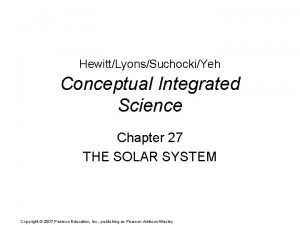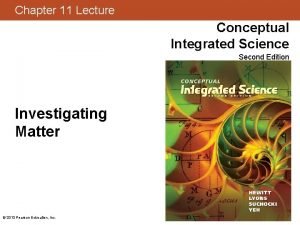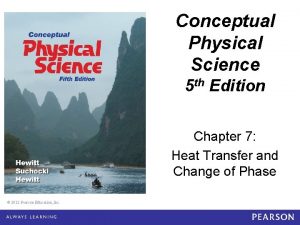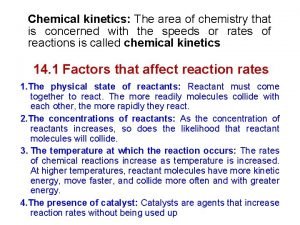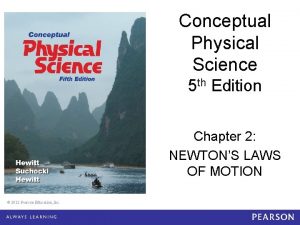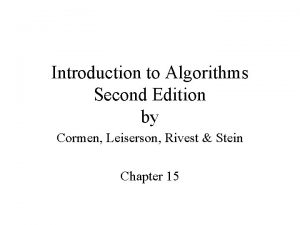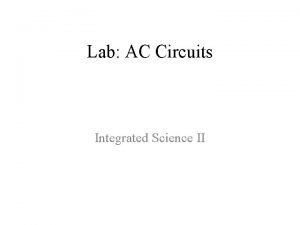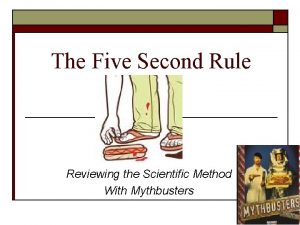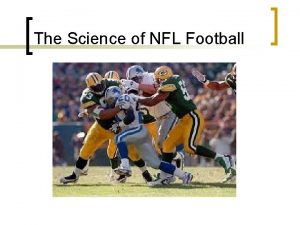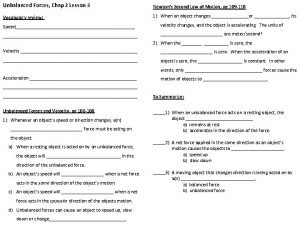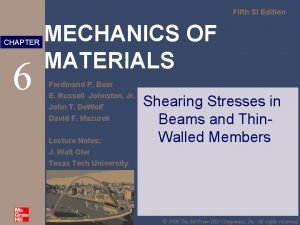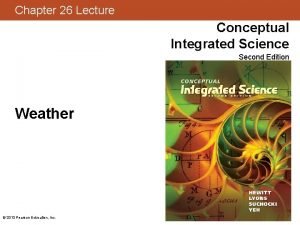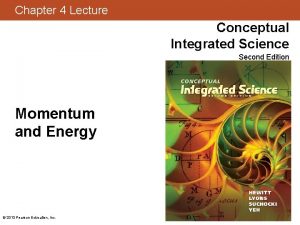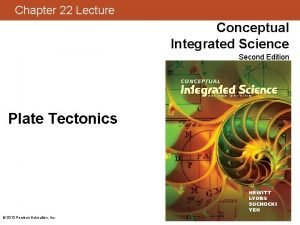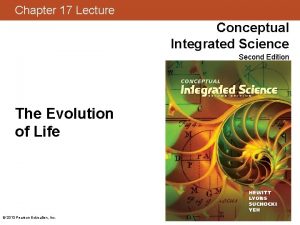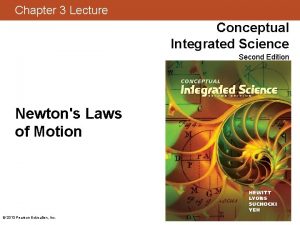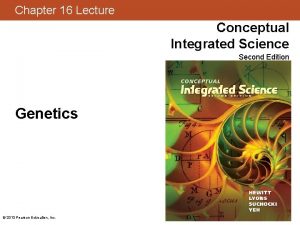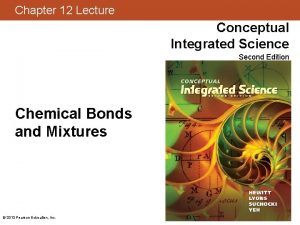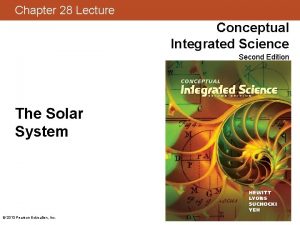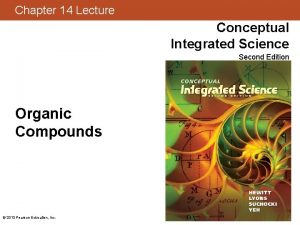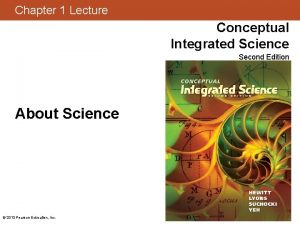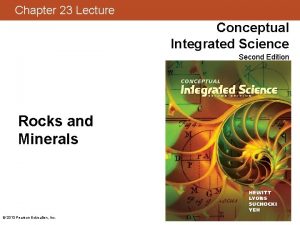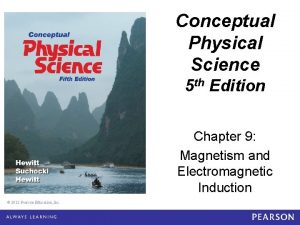Chapter 2 Lecture Conceptual Integrated Science Second Edition




















































- Slides: 52

Chapter 2 Lecture Conceptual Integrated Science Second Edition Describing Motion © 2013 Pearson Education, Inc.

This lecture will help you understand: • • • Aristotle on Motion Galileo's Concept of Inertia Mass—A Measure of Inertia Net Force The Equilibrium Rule The Support Force Equilibrium of Moving Things The Force of Friction Speed and Velocity Acceleration © 2013 Pearson Education, Inc.

Aristotle on Motion • Aristotle classified motion into two kinds: – Natural motion: motion that is straight up or straight down • Every object has its place and will strive to get there. – Violent motion: imposed motion resulting from an external push or pull • Pulling or lifting © 2013 Pearson Education, Inc.

Aristotle on Motion • Aristotle thought that heavier objects strove hard to return to their place than lighter objects. • Everything was composed of 4 elements – Earth, water, air and fire • In the early 1600’s Galileo demolished Aristotle’s belief that heavy objects fall faster than light ones. © 2013 Pearson Education, Inc.

Galileo's Concept of Inertia • In the absence of a force, objects once set in motion tend to continue moving indefinitely without friction. © 2013 Pearson Education, Inc.

Galileo's Concept of Inertia • Legend of the Leaning Tower of Pisa: – Galileo showed that dropped objects fall to the ground at the same time when air resistance is negligible. © 2013 Pearson Education, Inc.

Galileo's Concept of Inertia • Discovery: – In the absence of friction, no force is necessary to keep a horizontally moving object moving. © 2013 Pearson Education, Inc.

Galileo's Concept of Inertia • Experiment: – Balls rolling down inclined planes and then up others tend to roll back up to their original heights. © 2013 Pearson Education, Inc.

Galileo's Concept of Inertia • Conclusion: – The tendency of a moving body to keep moving is natural—every material object resists change in its state of motion. This property of things to resist change is called inertia. © 2013 Pearson Education, Inc.

Galileo's Concept of Inertia CHECK YOUR NEIGHBOR The use of inclined planes for Galileo's experiments helped him to A. B. C. D. eliminate the acceleration of free fall. discover the concept of energy. discover the property called inertia. discover the concept of momentum. Explain your answer to your neighbor. © 2013 Pearson Education, Inc.

Mass—A Measure of Inertia • The amount of inertia possessed by an object depends on the amount of matter—the amount of material that composes it, its mass: – Greater mass greater inertia – Smaller mass smaller inertia © 2013 Pearson Education, Inc.

Mass—A Measure of Inertia • Mass – Quantity of matter in an object – Measure of inertia or sluggishness that an object exhibits in response to any effort made to start it, stop it, or change its state of motion in any way © 2013 Pearson Education, Inc.

Mass—A Measure of Inertia • Weight: the amount of gravitational pull on an object • Weight and mass are proportional. – Twice the mass twice the weight – Half the mass half the weight © 2013 Pearson Education, Inc.

Mass—A Measure of Inertia • Mass versus volume – Mass involves how much matter an object contains. – Volume involves how much space an object occupies. © 2013 Pearson Education, Inc.

Mass—A Measure of Inertia CHECK YOUR NEIGHBOR The concept of inertia mostly involves A. B. C. D. mass. weight. volume. density. Explain your answer to your neighbor. © 2013 Pearson Education, Inc.

Mass—A Measure of Inertia • Standard unit of measurement for mass: the kilogram • One Kilogram (kg) of any material on Earth's surface weighs 10 newtons. • Away from the Earth, as on the Moon or other small bodies, 1 kg of material weighs less than 10 newtons. © 2013 Pearson Education, Inc.

Mass—A Measure of Inertia CHECK YOUR NEIGHBOR When the string is pulled down slowly, the top string breaks. This best illustrates the A. B. C. D. weight of the ball. mass of the ball. volume of the ball. density of the ball. Explain your answer to your neighbor. © 2013 Pearson Education, Inc.

Mass—A Measure of Inertia CHECK YOUR NEIGHBOR When the string is pulled down quickly, the bottom string breaks. This best illustrates the A. B. C. D. weight of the ball. mass of the ball. volume of the ball. density of the ball. Explain your answer to your neighbor. © 2013 Pearson Education, Inc.

Mass—A Measure of Inertia • Measure of compactness – Density is the measure of how much mass occupies a given space. – Equation for density: Density = in grams per cubic centimeter or kilograms per cubic meter © 2013 Pearson Education, Inc.

Mass—A Measure of Inertia CHECK YOUR NEIGHBOR The density of 1 kilogram of iron is A. B. C. D. less on the Moon. the same on the Moon. greater on the Moon. all of the above Explain your answer to your neighbor. © 2013 Pearson Education, Inc.

Net Force • Force is simply a push or a pull. • Net force is a combination of all the forces that act on an object. It is the net force that changes an object's state of motion. © 2013 Pearson Education, Inc.

Net Force • Vector quantity – Is both the magnitude (how much) and direction (which way). – The length of the arrow and direction can determine its magnitude and direction. © 2013 Pearson Education, Inc.

Net Force CHECK YOUR NEIGHBOR A cart is pushed to the right with a force of 15 N while being pulled to the left with a force of 20 N. The net force on the cart is A. B. C. D. 5 N to the left. 5 N to the right. 25 N to the left. 25 N to the right. Explain your answer to your neighbor. © 2013 Pearson Education, Inc.

The Equilibrium Rule • The equilibrium rule: – The vector sum of forces acting on a nonaccelerating object or system of objects equals zero. – Mathematical notation: F = 0 © 2013 Pearson Education, Inc.

The Equilibrium Rule © 2013 Pearson Education, Inc.

The Equilibrium Rule CHECK YOUR NEIGHBOR The equilibrium rule, F = 0, applies to A. B. C. D. vector quantities. scalar quantities. both vector and scalar quantities. neither vector nor scalar quantities. Explain your answer to your neighbor. © 2013 Pearson Education, Inc.

The Support Force • The force that supports an object on a surface against gravity is called the support force, often called the normal force = weight of the object. © 2013 Pearson Education, Inc.

The Support Force CHECK YOUR NEIGHBOR When you stand on two bathroom scales, with one foot on each scale and your weight evenly distributed, each scale will read A. B. C. D. your weight. half your weight. zero. actually more than your weight. Explain your answer to your neighbor. © 2013 Pearson Education, Inc.

Equilibrium of Moving Things • An object that moves at constant velocity is in equilibrium. • When two or more forces cancel to zero on a moving object, the object is in equilibrium. © 2013 Pearson Education, Inc.

Equilibrium of Moving Things CHECK YOUR NEIGHBOR A bowling ball is in equilibrium when it A. B. C. D. is at rest. moves steadily in a straight-line path. both of the above none of the above Explain your answer to your neighbor. © 2013 Pearson Education, Inc.

The Force of Friction • Friction – is the resistive force that opposes the motion or attempted motion of an object through a fluid or past another object with which it is in contact. – always acts in a direction to oppose motion. © 2013 Pearson Education, Inc.

The Force of Friction – Between two surfaces, the amount of friction depends on the kinds of material and how much they are pressed together. – Friction is due to surface bumps and also to the stickiness of atoms on the surfaces of the two materials. © 2013 Pearson Education, Inc.

The Force of Friction CHECK YOUR NEIGHBOR The force of friction can occur A. B. C. D. with sliding objects. in water. in air. all of the above Explain your answer to your neighbor. © 2013 Pearson Education, Inc.

The Force of Friction CHECK YOUR NEIGHBOR When Nellie pushes a crate across a factory floor at constant speed, the force of friction between the crate and the floor is A. B. C. D. less than Nellie's push. equal to Nellie's push. equal and opposite to Nellie's push. greater than Nellie's push. Explain your answer to your neighbor. © 2013 Pearson Education, Inc.

The Force of Friction CHECK YOUR NEIGHBOR When Nellie pushes a crate across a factory floor at an increasing speed, the amount of friction between the crate and the floor is A. B. C. D. less than Nellie's push. equal to Nellie's push. equal and opposite to Nellie's push. greater than Nellie's push. Explain your answer to your neighbor. © 2013 Pearson Education, Inc.

Speed and Velocity • Speed is the distance covered per amount of travel time. Equation for speed: Speed = © 2013 Pearson Education, Inc.

Speed and Velocity • Average speed is the total distance traveled divided by the time of travel. Equation for average speed: Average speed = • Instantaneous speed is the speed at any instant of time. © 2013 Pearson Education, Inc.

Speed and Velocity © 2013 Pearson Education, Inc.

Speed and Velocity • Velocity – When we know both the speed and direction of an object. • Motion is Relative – Everything is always moving – You are moving at 100, 000 km/h when compared to the Sun. – Velocity or Speed of an object are compared to something else. © 2013 Pearson Education, Inc.

Speed and Velocity CHECK YOUR NEIGHBOR The average speed in driving 30 km in 1 hour is the same as the average speed in driving A. B. C. D. 30 km in 1/2 hour. 30 km in 2 hours. 60 km in 1/2 hour. 60 km in 2 hours. Explain your answer to your neighbor. © 2013 Pearson Education, Inc.

Acceleration • Acceleration is the rate at which velocity changes with time. The change in velocity may be in magnitude, in direction, or both. Equation for acceleration: Acceleration = © 2013 Pearson Education, Inc.

Acceleration • Accelerating, braking (deceleration), or changing directions are all acceleration because the velocity of the object are changing. © 2013 Pearson Education, Inc.

Acceleration CHECK YOUR NEIGHBOR An automobile cannot maintain a constant speed when A. B. C. D. accelerating. rounding a curve. both of the above none of the above Explain your answer to your neighbor. © 2013 Pearson Education, Inc.

Acceleration CHECK YOUR NEIGHBOR Acceleration and velocity are actually A. B. C. D. much the same. rates, but for different quantities. the same when direction is not a factor. the same for free-fall situations. Explain your answer to your neighbor. © 2013 Pearson Education, Inc.

Acceleration Free fall When the only force acting on a falling object is gravity (with negligible air resistance), the object is in a state of free fall. © 2013 Pearson Education, Inc.

Acceleration • Acceleration of free fall is 9. 8 m/s 2 • This is also the pull of gravity on any object © 2013 Pearson Education, Inc.

Acceleration • Hangtime – How high can you jump – It is almost always less than 1 second when jumping straight up. – d = ½ g t 2 • d = distance in meters • g = gravity • t = time © 2013 Pearson Education, Inc.

Acceleration • A vertical jump of. 6 meters or 2 feet is exceptional. • World record is 1. 25 m • Their hang time was. 5 seconds each way for a total of 1 s • Jumping ability increases with the length of your legs and strength of your muscles © 2013 Pearson Education, Inc.

Acceleration © 2013 Pearson Education, Inc.

Acceleration CHECK YOUR NEIGHBOR If a falling object gains 10 m/s each second it falls, its acceleration is A. 10 m/s. B. 10 m/s per second. C. both of the above D. neither of the above Explain your answer to your neighbor. © 2013 Pearson Education, Inc.

Acceleration CHECK YOUR NEIGHBOR A free-falling object has a speed of 30 m/s at one instant. Exactly one second later its speed will be A. the same. B. 35 m/s. C. greater than 35 m/s. D. 60 m/s. Explain your answer to your neighbor. © 2013 Pearson Education, Inc.

Acceleration CHECK YOUR NEIGHBOR The distance fallen by a free-falling body A. B. C. D. remains constant each second of fall. increases each second when falling. decreases each second when falling. none of the above Explain your answer to your neighbor. © 2013 Pearson Education, Inc.
 Conceptual integrated science explorations
Conceptual integrated science explorations Conceptual integrated science
Conceptual integrated science When air rapidly expands its temperature normally
When air rapidly expands its temperature normally Heat is simply another word for
Heat is simply another word for Conceptual physical science 5th edition
Conceptual physical science 5th edition 01:640:244 lecture notes - lecture 15: plat, idah, farad
01:640:244 lecture notes - lecture 15: plat, idah, farad Second order integrated rate law
Second order integrated rate law Second order integrated rate law
Second order integrated rate law Nina’s favorite subject is science
Nina’s favorite subject is science Integrated brand promotion (ibp) is:
Integrated brand promotion (ibp) is: Conceptual physical science practice sheet chapter 2
Conceptual physical science practice sheet chapter 2 186 282 miles per second into meters per second
186 282 miles per second into meters per second Advanced word power second edition answers
Advanced word power second edition answers Accounting principles second canadian edition
Accounting principles second canadian edition Accounting principles second canadian edition
Accounting principles second canadian edition Accounting principles second canadian edition
Accounting principles second canadian edition Clear thinking and writing answer key
Clear thinking and writing answer key Accounting principles second canadian edition
Accounting principles second canadian edition Kaufman tamine
Kaufman tamine Introduction to algorithms 2nd edition
Introduction to algorithms 2nd edition In company second edition
In company second edition Wechsler individual achievement test second edition
Wechsler individual achievement test second edition Ten steps advanced reading answer key
Ten steps advanced reading answer key Organic chemistry
Organic chemistry Using mis (10th edition) 10th edition
Using mis (10th edition) 10th edition Using mis (10th edition) 10th edition
Using mis (10th edition) 10th edition Conceptual framework for financial reporting
Conceptual framework for financial reporting Physical science lecture notes
Physical science lecture notes What is matter in integrated science
What is matter in integrated science Registered nurse lone star college
Registered nurse lone star college Integrated science lab experiments
Integrated science lab experiments Chs hcpss
Chs hcpss 5 second rule science experiment
5 second rule science experiment The science of nfl football
The science of nfl football The central science 14th edition
The central science 14th edition Biological science 6th edition
Biological science 6th edition Todd f. heatherton
Todd f. heatherton The fundamentals of political science research 2nd edition
The fundamentals of political science research 2nd edition Political science 14th edition
Political science 14th edition Political science 14th edition
Political science 14th edition Science power 9 atlantic edition
Science power 9 atlantic edition What is conceptual framework of science education
What is conceptual framework of science education Human resource management lecture chapter 1
Human resource management lecture chapter 1 Human resource management lecture chapter 1
Human resource management lecture chapter 1 Human resource management lecture chapter 1
Human resource management lecture chapter 1 The second new deal takes hold chapter 15 section 2
The second new deal takes hold chapter 15 section 2 Second great awakening apush chapter 15
Second great awakening apush chapter 15 Chapter 2 lesson 3 newton's second law
Chapter 2 lesson 3 newton's second law Organizational behavior chapter 1
Organizational behavior chapter 1 Organic chemistry (3rd) edition chapter 1 problem 16s
Organic chemistry (3rd) edition chapter 1 problem 16s Beer johnston
Beer johnston Mechanics of materials 7th edition solutions chapter 7
Mechanics of materials 7th edition solutions chapter 7 Mechanics
Mechanics
